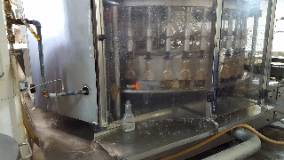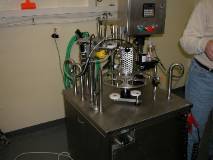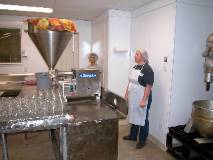Filler Identification and Selection for Liquid Foods
Introduction
Fillers in the food industry are devices that are used to accurately and cleanly place a specified amount of product into a container. The objectives of this fact sheet are to describe the types of fillers available for liquid food products and provide selection criterion for the best alternative.
National Institute of Standards and Technology
The National Institute of Standards and Technology (NIST, 2019) publishes the official guide for testing the net contents of packaged products sold in the United States (Available at: https://nvlpubs.nist.gov/nistpubs/hb/2019/NIST.HB.133-2019.pdf). Enforcement organizations follow the NIST standard for label compliance of net contents. Food manufacturers should be aware of the testing methods and pack products accordingly. Agencies responsible for packaging regulations include: Alcohol and Tobacco Tax and Trade Bureau, FDA, local weights and measures, state and local weight and measures, and U.S. Department of Agriculture Food Safety and Inspection Service.

Types of Fillers Available
Liquid fillers for foods are available from a number of manufacturers in a variety of designs. Most fillers are primarily constructed of stainless steel, plastics and elastomeric materials. Table 1 lists broad categories of filler designs that are popular.
Table 1. Popular filler types for liquid food products.
| Design Category | Description |
|---|---|
| Pump | A pump, controls, piping and valves are used to fill containers. Pump fillers are common for low-speed filling of viscous products like honey. |
| Piston | A piston reciprocates in a chamber with a product valve on one end. The chamber is filled with product as the piston creates a vacuum when moved away from the valve-end of the chamber. Product is emptied into a container when the piston returns to the valve end of the chamber, forcing the product out. Piston fillers are commonly used for high speed, accurate filling operations for more viscous products like creams and purees. |
| Net weight | Individual scales weigh the product and container. The container may be weighed individually (tared), or a constant weight is assumed. Net weight fillers are often used with large-volume containers (e.g. pail, drum and tote). |
| Mass flow | A prescribed mass of product is measured using an accurate mass flow meter (e.g. Coriolis flow sensor) and dosed into a container. |
| Overflow | Containers may be tilted and passed under freely-flowing product (e.g. waterfall). Product fills the container to over- flowing. When the container is set upright, the fill level is at target. Normally used on water-like products. |
| Gravity overflow | A fill head seals on the finish of the container and product flows, via gravity, into the container through a spout. A nozzle opening (built into the fill head) provides a return path, or vent, for air and product when the container is filled. The product reservoir is located above the fill head (normally a filler bowl) to promote gravity flow. |
| Pressure overflow | Similar to gravity overflow, except product flow is powered by a pump, or other source of pressure. The fill head seals on the container finish, and a spout enters the container to fill it with product. When the product reaches the opening in the return line (built into the fill head) it returns back to the filler. |
| Counter-pressure | A fill head seals on the finish of the container. Gas (e.g. CO2) is released into the container to purge air and create a constant pressure. The pressure in the container is equal to or slightly greater than the fluid pressure for filling. When gas pressure in the container is reduced, fluid enters. Pressure fillers are effective at reducing product foaming. |
Criterion for Filling Liquid Foods
Table 2 lists some of the criterion that may be considered when selecting a filler for liquid foods. To make the most of the criterion, the user can assign a numerical weight to each of the criterion that is deemed important (e.g. weight from 1 to 10; where price might be assigned a weight of “10,” most important criterion, and enclosures a weight of “2,” much less important criterion). Next the user may score each filler choice on the important criterion, according to their judgment (e.g. price of filler A scores “1,” lowest value and price of filler B scores “5,” mid-range value). Multiply the assigned weight by the score for each criterion to compute the weighted score for each criterion. Sum the total of the weighted scores. The filler with the highest sum of weighted scores is selected for purchase. A shortened example of an evaluation of alternative fillers using weighted scores is shown in Table 3. Based on the overall weighted score in Table 3, filler alternative “A” should be selected over “B.”
Table 2. Criterion for selecting a liquid food filler, incomplete list in alphabetical order.
| # | Criterion | Purpose |
|---|---|---|
| 1 | Accuracy of fill | Reduce product give-away. |
| 2 | Change parts | Change parts may be required to run certain container sizes/products. Change parts must be rugged and simple to install. |
| 3 | Cleanability | All surfaces, especially product contact, must be cleanable to the microbiological level and accessible for inspection. A filler designed for Clean-In-Place (CIP) can be cleaned without disassembly. |
| 4 | Container infeed and outfeed | Positive handling of containers without damage, drops or spills, including handoff to next process (e.g. capper). |
| 5 | Control of container | Maintains position of container without tipping, shaking or vibrating. |
| 6 | Enclosures | Electrical enclosures should be corrosion resistant, watertight and cleanable. |
| 7 | Footprint and access | Must fit in the available space, including access for maintenance and cleaning. |
| 8 | Hoses | Use of hoses should be minimized and hose clamps eliminated. |
| 9 | Installation | Access to installation area, installation process and cost. |
| 10 | Integration | The filler must integrate with upstream and downstream equipment and controls. A “Monoblock” filler has an inte- grated capper on a common foundation. |
| 11 | Labels | All controls should be clearly labeled. Wiring should be labeled individually at each terminal. |
| 12 | Manuals | Detailed and useful manuals for operation and maintenance should be available, along with a wiring schematic. |
| 13 | Materials of construction |
Materials should not corrode due to interactions with product(s) and cleaning chemicals. |
| 14 | No-container, no-fill | Product will not be discharged from the fill nozzle if a container is not present. |
| 15 | Operating temperature range | The machine is capable of operating efficiently at the desired fill temperature. |
| 16 | Price | Must be affordable, including ongoing expenses of operation. |
| 17 | Product properties | Unique product properties should be considered, such as foaming, viscosity, settling, heat sensitivity, shear sensitivity and oxidation. |
| 18 | Range of fill volume/containers | The filler must be capable of filling the range of containers expected. |
| 19 | Safety | Adequate safety guards and lockout devices must be included for operators, maintenance and cleaning. |
| 20 | Sanitary design | All internal and external surfaces must be sloped and designed to freely drain (not capture fluids). Surfaces should be polished with smooth curves and fillets. |
| 21 | Sanitation | An effective sanitizing cycle, or process, must be possible. |
| 22 | Spare parts | Availability and cost. |
| 23 | Speed of fill | Determines if the filler will meet rate of production demands. |
| 24 | Standards | When applicable, a filler should meet industry standards (e.g. 3A, NSF, ANSI, ASTM, EHEDG, OSHA) for food and hu- man safety. |
| 25 | Training | Availability and cost of training for all operators, sanitors and maintenance personnel. |
Table 3. Abbreviated example of an evaluation of alternative fillers “A” and “B” by weighted score.
| # | Important Criterion |
Weight | Filler A Score | Filler B Score | Filler A Weighted Score | Filler B Weighted Score |
|---|---|---|---|---|---|---|
| 1 | Price | 10 | 6 | 10 | 60 | 100 |
| 2 | Cleanability | 7 | 9 | 7 | 63 | 49 |
| 3 | Footprint | 5 | 10 | 6 | 50 | 30 |
| 4 | Safety | 10 | 9 | 7 | 90 | 70 |
| 5 | Range of fill | 8 | 8 | 5 | 64 | 40 |
| TOTAL | 327 | 289 |
Sources for locating filling equipment are available online. Examples include: foodmaster.com, thepackaginguide.com, packagingdigest.com and packworld.com.
Considerations for Glass Containers
Glass containers are prone to breakage, and glass pieces are hazardous and regarded as an adulterant. Detection of broken, cracked or chipped glass during filling operations should trigger a sequence of corrective actions. Corrective actions might include: clearing of broken containers and glass pieces from the production line, repair or adjustment of machine elements and product holds for inspection. Line speeds for glass containers may be limited to reduce handling issues and consequential breaks. Fillers with nozzles that do not contact, or minimally contact, the glass surface may be selected to reduce opportunity for glass chipping and breakage.
Considerations for Plastic Containers
Rigid plastic containers may deform easily when handled, especially if they are filled with hot product. Improved plastic formulations and increased wall thickness may be required to fill hot products. Some plastic containers have reinforced neck areas and flanges, or other features that facilitate handling during filling and capping for properly equipped machines. Inert gas (e.g. N2) may be dosed into the headspace of filled containers to increase internal pressure and decrease container paneling. Non-rigid plastic containers (pouches) are normally handled by their spout or neck area.
Safety
Product safety is impacted by filler design. Fillers should protect the product from exposure to outside contaminants. Protection from contaminants might include the body of the filler, covers, shrouding, and filtered air or inert gas blankets. Fillers must be cleanable (inside and out), to prevent accumulation and growth of unwanted organisms and biofilms. A viable cleaning and sanitation plan must be prepared for all product contact surfaces.
Human safety is integral to filler design. Dangerous conditions should be eliminated in preference to safeguarding. Pinch points, rotating shafts, belts, gears and components must be guarded. Hot surfaces should be inaccessible or protected from human contact. Machine adjustments undertaken during operations (such as fill cycle speed, air pressure and conveyor speed) must be accomplished outside of the guarded or danger areas. Stairs, platforms and ladders (if supplied) must be designed to regulatory specifications. Safety interlocks, emergency stop and lock-out-tag-out features must be effective and straightforward to use. Noise level of the machinery should be minimized. Operator ergonomics need to be considered (height, reach and dexterity) for controls, change parts, maintenance and cleanup.
Conclusion
Filling operations are at the heart of a liquid food processing line. A wide range of filler types and options are available from a large number of manufacturers and suppliers. Identification and selection of the best filler is an important step in the design of a successful processing line. A filler type can be identified based on the descriptions in Table 1. Suitability of a given filler, installed in a specific facility, may be assessing by applying criteria listed in Table 2, considering the unique product(s) and container(s) intended for filling.
Figure 1. Gravity overflow rotary filler for syrup.
Figure 2. Pump rotary filler for dairy products.
Figure 3. Piston filler with manual container handling.
Reference
NIST. 2019. Handbook 133-2019, Checking the Net Contents of Packaged Goods. Available at: https://nvlpubs.nist.gov/nistpubs/hb/2019/NIST.HB.133-2019.pdf. Accessed September 17, 2019.



